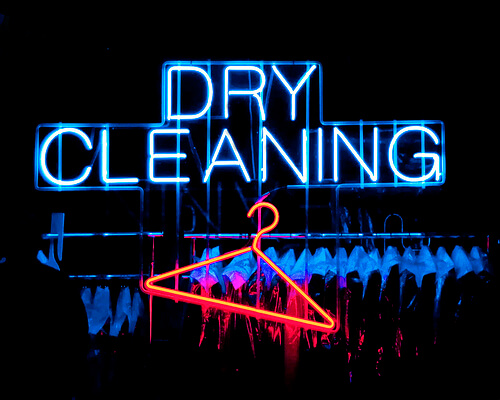
Take a minute to look at the care labels sewn in the seam inside your clothes. On the label, you’ll find a wealth of information from the fiber content of the fabric to where the garment was made and how to clean the garment.
More and more items, even simple T-shirts and jeans, are labeled as “Dry Clean Only”. Many clothing manufacturers recommend the most conservative type of cleaning treatment of the fabric to ensure the best results for the consumer.
Dark blue denim jeans may receive the “Dry Clean Only” label to prevent fading or the jeans may have embellishments like leather trim or studs that could cause issues when, in fact, they can be washed just like any jeans.
For instance, some fabrics that are labeled as dry clean can be hand washed or cleaned with a do-it-yourself dry clean kit at home. But should you? Would a professional dry cleaner do a better job?. This is why it is important to note the fiber content of the fabric so you can make an informed laundry decision.
How to Decide Whether to Wash or Dry Clean Clothes
If you are experienced in doing laundry, you will soon learn – often from trial and error – the best way to clean clothes. The care label, type of fabric and the way the garment is constructed will help you make the decision on how it should be cleaned.
But if you are a novice at doing laundry or uncertain about what to do when a piece of clothing is label as “Dry Clean Only”, either follow the care label guidelines fully or use these guidelines to help you make a decision.
If the answer to any of these question is “yes”, take your garment to a professional dry cleaner.
Are there spots or stains on the garment that you don’t know how to treat?
Is the garment made from acetate, triacetate, or rayon? While these fabrics can be hand washed in cold water, both can shrink or become misshapen in water.
- Is there a special finish on the garment? Stiff fabrics have a stabilizing finish to help them hold their shape that water can ruin.
- Is the garment difficult to iron? If there are lots of pleats or tucks to iron, you may never get them to look crisp again.
- Is the garment structured or tailored like a coat or suit jacket? Even though the outside fabric may be washable, the interfacings that give labels and shoulders their shape may be ruined by water.
- If the garment is lined, are both the inner and outer fabrics washable? Different types of fabric have different shrinkage rates that can leave linings showing after being washed with water.
- Is the garment trimmed with or made of leather or suede? Water can strip the natural oils and ruin the finish.
- Does the fabric transfer dye when it gets wet? You can test whether the fabric is colorfast by wetting a cotton swab with plain water and rub it on an inside seam or hem. If color comes off the surface of the fabric onto the swab, it needs special treatment when washing or dry cleaning.
- Is the garment made of a fiber that you’re not familiar with and have never successfully home laundered?
- Is the garment expensive or special to you? If you ruin it by washing at home, will you be upset? Remember that many laundry mishaps can not be easily reversed and most are permanently ruined.
- Is the garment several seasons old? It is important to consider the value of the garment in comparison to repeated dry cleaning costs.
Remember, just one “yes” means that you should ask someone who is more experienced in doing laundry for a recommendation or head to the dry cleaner!
4 Tips for Washing Dry Clean Only Clothes
If you’ve decided to give washing a garment that’s labeled “Dry Clean Only” a try, here are some general tips that you should follow:
- Always use cold water and a gentle detergent (Woolite is a brand name) for the first washing.
- Wash the item alone. Do not mix with other garments until you see how it goes.
- Hand washing is best. If you decide to use the washing machine, opt for the gentle cycle. Excessive wringing and agitation can cause problems.
- Skip the clothes dryer. If the garment is a knit, dry flat to prevent stretching. If it is a woven garment, hang to drip dry.
Article Credit Here

